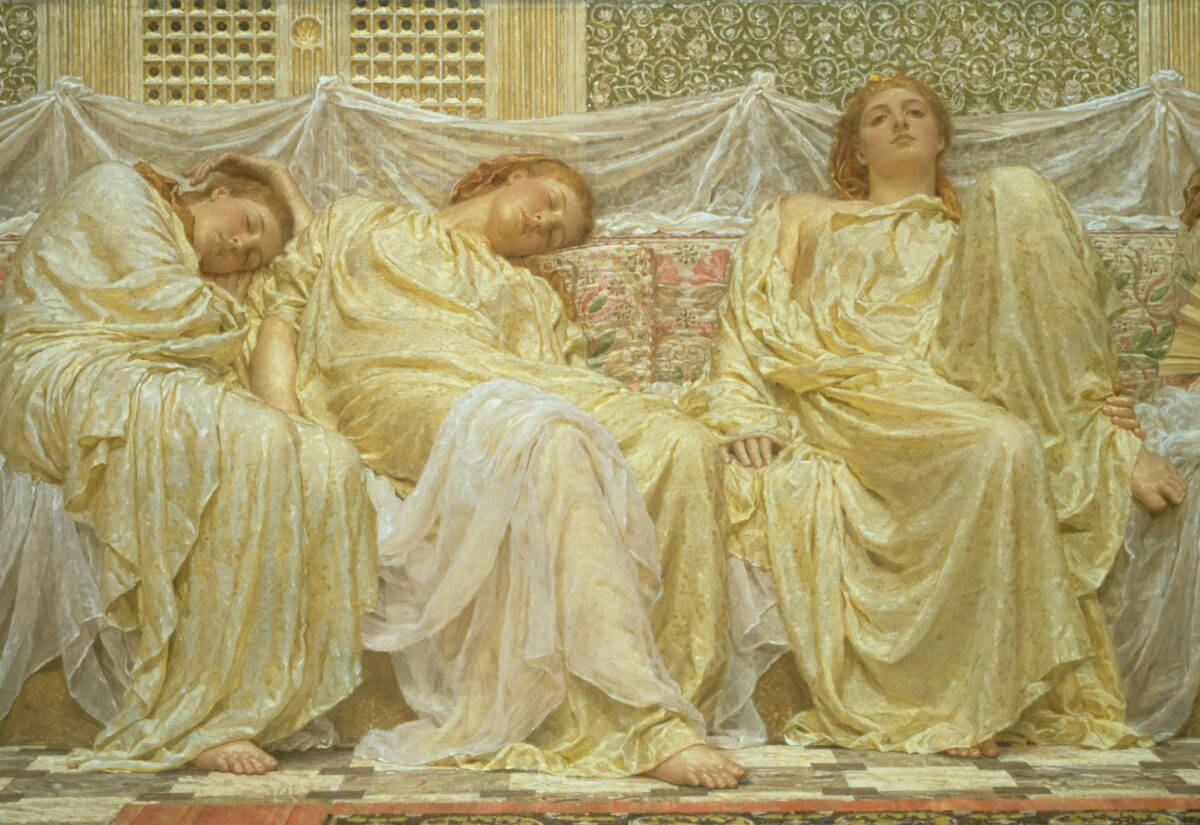 Unsplash/Birmingham Museums Trust
Unsplash/Birmingham Museums TrustThroughout history, people have gone to great lengths to get a good night’s sleep, or at least to follow the traditions and beliefs of their time about how, where, and with whom one should sleep. But not all sleeping arrangements were what we’d consider restful today. Some were dictated by climate, class, religion, or superstition, while others were simply bizarre by modern standards. From upright snoozing to communal beds with strangers, people have adapted to their environments in some incredibly creative (and at times unsettling) ways. Here are some sleeping arrangements from the past that range from the inventive to the downright strange, with a few that might still have some relevance (or at least curiosity value) today.
Upright sleeping in the Middle Ages
In medieval Europe, particularly among the upper classes, it was common to sleep in a partially upright position. Beds were often constructed with steep headboards and propped-up pillows to keep the sleeper from lying completely flat. This wasn’t just a matter of comfort; it was tied to belief systems. Lying flat was associated with death and vulnerability to spiritual intrusion, so sitting upright was considered safer.
Some historians believe this position may also have helped with practical issues like acid reflux or breathing difficulties, especially in cold, smoke-filled houses with limited ventilation. The upright sleeping posture was also considered more dignified—something befitting nobility, even in rest. It wasn’t until much later, with improved mattresses and better heating, that lying flat became the default sleeping style.
Two sleeps a night
Before artificial lighting changed our biological clocks, many people followed what’s now known as segmented sleep. The “first sleep” would begin shortly after nightfall and last for several hours. After waking naturally in the middle of the night, people would stay awake for an hour or two—reading, praying, talking with their partner, or even going out to visit neighbours—before settling in for their “second sleep.”
This practice was common in Britain and across Europe and is well documented in court records, diaries, and literature. Historian Roger Ekirch has written extensively on this topic, arguing that the two-part sleep was a natural response to long hours of darkness before the invention of electric lighting. Some sleep scientists today even argue that our modern struggles with insomnia could be a biological hangover from this natural rhythm.
Sleeping in cupboard beds
In 17th-century Scotland, the Netherlands, and parts of France, people slept in wooden box beds—essentially enclosed sleeping compartments built into the wall or free-standing furniture. These beds often had doors or heavy curtains, turning them into mini sleeping rooms. Known as “bed closets,” they provided insulation and privacy in one-room cottages.
They also served as social hubs, especially in the long, cold months. People would sit in the bed to chat, knit, or tell stories before lying down to sleep. In large households, several people might share the same bed closet. This enclosed design trapped body heat and was particularly valuable in colder climates, reducing the need for constant firewood or expensive heating fuel.
Shared beds with strangers
Inns and taverns of early modern Britain often had limited space, and rather than renting a private room, travellers would rent a bed. That bed could be shared with complete strangers. The arrangement wasn’t seen as shocking, just practical.
This system was based on economy and necessity, not intimacy. Some inns used dividers or bolsters to separate sleepers, while others offered no boundaries at all. Sometimes, people would talk through the night; in other cases, they slept back-to-back, trying to ignore each other. Occasionally, this kind of enforced closeness led to new friendships, or even marriages. It was all part of the unpredictability of life on the road.
Sleeping on ropes instead of mattresses
For those who couldn’t afford feather beds or even straw ticks, rope beds offered a cheaper alternative. These beds consisted of a wooden frame laced with ropes criss-crossed to support a sleeping surface. A thin mattress or sack of hay was laid on top. Over time, the ropes would sag and need tightening, a chore that led to the origin of the phrase “sleep tight.”
Though rudimentary, rope beds were reasonably comfortable when well-maintained. In poorer homes, people might sleep directly on the ropes with just a blanket. Some taverns offered rope beds where guests paid to sleep sitting up, strung across a line like laundry. These “penny hangs” were the cheapest way to sleep indoors.
Children swaddled in sleep boards
Swaddling was an ancient practice designed to keep infants warm and their limbs straight. In medieval and Renaissance Europe, swaddling could involve binding a baby so tightly they couldn’t move at all, often strapping them to a board or securing them inside a rigid cradle.
These devices were meant to prevent injury, keep babies quiet, and train their bodies into desired shapes. While some swaddling practices offered comfort and security, others veered into the extreme. Babies might be left in the same position for hours, only changed or fed at designated times. Today’s version of swaddling is much gentler, but its historical roots show how rigid ideas of health and morality shaped child-rearing practices.
Cold-weather spooning under communal blankets
In frigid rural areas such as the Scottish Highlands, the Alps, or Scandinavian villages, communal sleeping wasn’t just convenient; it was a necessity. Entire families, and sometimes even neighbours or travellers, would pile into one bed to share warmth. In poorly insulated homes with no central heating, sleeping alone could be dangerous.
Beds were often so crowded that people slept in shifts or head-to-toe to maximise space. In some cases, communal beds were custom-built for multiple occupants. In farming households, workers during busy seasons might also sleep in shared quarters, creating a surprisingly social experience out of bedtime.
Sleeping with a corpse
As unsettling as it sounds, sleeping near the deceased was historically common in situations where bodies couldn’t be removed immediately. During the plague, in isolated cottages, or in overcrowded tenements, it wasn’t unusual for someone to sleep beside a recently deceased relative until burial could be arranged.
Cultural practices also played a role. In some regions, it was considered respectful to keep vigil over the dead. In others, the fear of disturbing a lingering soul meant staying close until the spirit had “moved on.” Though largely unthinkable today, it was once an accepted, even necessary, part of life in cramped or communal homes.
Monks sleeping in their robes, sitting upright
Medieval monastic life was governed by strict routines and values that discouraged indulgence. Sleep was necessary but minimised. Monks often slept in their robes, on hard surfaces, sometimes even on benches or sitting upright. This posture helped them avoid oversleeping and made it easier to rise for early prayers, which could be as early as 2 or 3 a.m.
Some orders allowed only brief periods of rest and required monks to remain half-awake, symbolising constant vigilance and readiness for divine duty. While this sounds exhausting, it was seen as an honourable sacrifice—a way of maintaining spiritual focus and resisting worldly comfort.
Napping in public for health
In ancient Greece and Rome, the afternoon nap (or siesta) was an accepted and even encouraged practice. With the hot Mediterranean climate and flexible working hours, many people took a break during the early afternoon to rest. This might be in a shaded courtyard, a communal garden, or even the public baths.
Elite Romans had designated rooms for napping, while philosophers and poets often embraced rest as a way to refresh the mind. Today, the concept of the power nap isn’t so far removed, but back then, it was seen as a sign of balanced living, not laziness.
Sleeping in shifts in industrial Britain
The Industrial Revolution ushered in brutal working conditions and extreme overcrowding, especially in factory towns. In working-class families, sleep was sometimes organised in shifts. Beds were used by one person while another worked, with little time in between. This system, known as “hot bedding,” ensured that beds were constantly in use, and always warm.
In boarding houses or tenements, several unrelated people might share the same bed in a 24-hour cycle. Privacy was non-existent. These arrangements were driven by necessity, not comfort, and reflected the harsh economic realities of life for many workers in the 19th century.
Sleep is universal, but the way we’ve approached it across history has been anything but consistent. From superstition and survival to social practicality, people have always found ways to rest within the boundaries of their time and environment. While we might not want to swap memory foam for rope beds or spooning strangers anytime soon, the history of sleep is a fascinating reminder that there’s no such thing as a truly “normal” bedtime routine, only what works in the moment.



